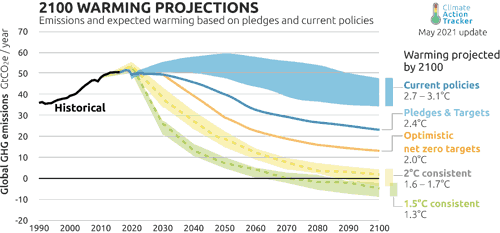Over the course of the summer, we witnessed yet more ‘once in a lifetime’ climatic events that are unfortunately becoming our new norm.
Canada has witnessed record temperatures of a staggering 49.6°C; shocking flash floods in Germany and Belgium killed more than 180 people; Underground stations were left underwater in London and New York; wildfires devasted Greece, Turkey and Siberia (so much so that this summer has had the highest level of carbon emissions from wildfires ever recorded during summer in the Northern Hemisphere[i]), and a late-summer heatwave has caused rain to fall on top of the Greenland ice cap for the first time in recorded history, accelerating melting.
Perhaps, worst of all, we have recently lost one of our greatest allies in our struggle against the steady and destructive march of climate change – the Amazon rainforest now emits more carbon dioxide than it absorbs per year.[ii] We cannot say we were not warned.
Even if we cut all global greenhouse gas emissions today, we would still experience these new events every year. To reiterate, this is the new norm. And we’re only at 1.2°C of warming above pre-industrial levels.
The proof is in the numbers
To meet the IPCC 1.5°C pathway we must cut global emissions by 7.6% every year from now to 2030. Even if we want to curb our ambitions, we will still have to cut emissions by 2.7% a year through to 2030 to meet the 2°C pathway.[iii]
So, how are we doing currently? The policies presently in place around the world are projected to result in roughly 3°C of warming above pre-industrial levels.[iv] Clearly, COP 26 cannot come soon enough. However, it is not enough to wait for government-driven policy and action. Every one of us has an individual and collective responsibility to drive change, and that includes private companies. Our own research shows that the financial sector recognises that but is failing to act on that at the moment; 90 percent of Private Equity firms globally agree climate change is an urgent issue, but just 44 percent measure their own carbon footprint and only half that of their investments. The time for talk is over. The time to act is now.

Fig. 1 Emissions pathways and the resultant expected level of atmospheric warming. Note that we’re currently on track for 3°C of warming.
Taken from: Climate Action Tracker, May 2021. ‘Warming Projections Global Update’
Carbon neutrality and beyond
So, what can private companies do to mitigate their contribution to climate change and work towards carbon neutrality and ultimately net-zero?
- Conduct a carbon footprint assessment of your company – at minimum Scope 1 and 2 emissions, including at least some Scope 3 sources if possible
- Integrate climate change considerations into your company’s governance
- Set out an overall climate change strategy for identifying climate-related risks and opportunities
- Set science-based targets for reducing your company’s greenhouse gas emissions
- Reduce your company’s emissions in line with the science-based targets
- Offset any emissions that you cannot reduce, through verified carbon offsetting projects that are additional (ie capturing or avoiding carbon that would not otherwise be captured or avoided)
- Repeat steps 1, 5 and 6 until the science-based targets are reached and your company is net-zero
Where do I begin?
Kickstart the process by initiating step 1 and perform a carbon footprint assessment on your company. Try and include as many emissions sources in the assessment as possible but remember that it is ok to start simple and increase the coverage over time. Some action is better than no action.
Apex ESG has an intuitive, easy-to-use software tool, that makes it straightforward to report any necessary raw data: electricity consumption, fuel use, waste production, travel data, water consumption and everything in else in your value chain. Using real data will always be more accurate than sectoral and geographic assumptions/approximations. Once a team of Apex ESG analysts have independently reviewed the data, the tool uses a bank of over 1 million emissions factors to calculate your carbon footprint quickly and accurately. It really is as simple as that.
If we have any chance of meeting the 1.5°C pathway, your company must also reduce its emissions. Apex ESG can help you to identify your major sources of emissions, set science-based reduction targets and then advise you on how to actually reduce those emissions in practice.
The final piece of the jigsaw is carbon offsetting. For the emissions that you cannot reduce and prevent, you will have to offset them. However, remember that offsetting is not the solution but rather the last resort. If your company is truly on the path to net-zero it should be purchasing fewer carbon offsets each year as it continually reduces its emissions.
Apex ESG has the tools to assist your company in playing its part in the fight against climate change. Do not look back with guilt. The climate clock is ticking and the time to act is now.
Contact us for more information on Apex ESG’s Carbon Footprint Assessment and Reporting tools.
[i] Bloomberg, 21 September 2021. ‘Devastating Wildfires Led to Record-High Emissions This Summer’. Available at: https://www.bloomberg.com/news/articles/2021-09-21/devastating-wildfires-led-to-record-high-emissions-this-summer?srnd=green
[ii] Gatti, L.V., Basso, L.S., Miller, J.B., Gloor, M., Gatti Domingues, L., Cassol, H.L., Tejada, G., Aragão, L.E., Nobre, C., Peters, W. and Marani, L., 2021. Amazonia as a carbon source linked to deforestation and climate change. Nature, 595(7867), pp.388-393.
[iii] UNEP, 26 November 2019. ‘Cut global emissions by 7.6 percent every year for next decade to meet 1.5°C Paris target – UN report’. Available at: https://www.unep.org/news-and-stories/press-release/cut-global-emissions-76-percent-every-year-next-decade-meet-15degc
[iv] Climate Action Tracker, May 2021. ‘Warming Projections Global Update’. Available at: https://climateactiontracker.org/documents/853/CAT_2021-05-04_Briefing_Global-Update_Climate-Summit-Momentum.pdf






